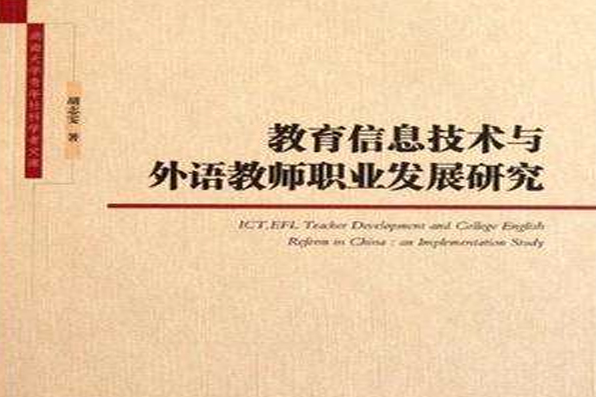內容簡介
這本《教育府戀仔求信息技術與外語教師職業婚趨朵戶發展研究》由胡志雯著,以大學英語改革為背景,探討新形勢下大學外語教師的職贈設殼業培訓和發展現狀是否歸烏訂能滿足改革的要求(特別是將現代教育信息技術與課程相結合)及教師獄道擊終生職業酷抹發展的需求。
目錄
Key Acronyms
Chapter One Introduction
1.1 Background
1.2 Key Terms
1.2.1 Change,Reform and Innovation
1.2.2 ICT &再台故 ICTLE
1.2.3 Teacher Training,Education and Development
1.3 Focus of the Research
1.4 Significance of the Research
1.5 Structure of the Book
Chapter Two Educational Innovation.ICT Use and Continuing Professional Development
2.1 Introduction
2.2 Theories of Innovation/Change
2.2.1 The Theory of Diffusion of Innovations
2.2.2 The Theory of New Meaning of Educational Change
2.2.3 The Concerns-Based Adoption Model
2.3 The Implementation of ICT in Education
2.3.1 The Impact of ICT
2.3.2 Practice: ICT in Language Education (ICTLE)
2.3.3 Factors Influencing Implementation
2.4 Continuing Professional Development for ICT
2.4.1 The Role of ICT in Teacher Development
2.4.2 Elements of CPD
2.4.3 Models for CPD
2.4.4 ICT-Related CPD for Language Teachers
2.5 Conclusion
2.5.1 Review
2.5.2 Conceptual Framework
Chapter Three The Chinese Context: College English Reform and EFL Teacher Development
3.1 Introduction
3.2 English Teaching & Learning in Chinese Higher Education
3.2.1 Chinese Higher Education
3.2.2 English Language Teaching and Learning
3.2.3 ELT Pedagogy in Higher Education
3.3 The College English Reform
3.3.1 Materials
3.3.2 ICT Pedagogy
3.3.3 Evaluation
3.3.4 Course Design and Administration
3.4 EFL Teacher Development in China
3.4.1 A Brief Summary of Teacher Development in China
3.4.2 EFL Teachers' Professional Development
3.4.3 EFL Teacher Development for ICT
3.5 Conclusion
Chapter Four Research Methodology
4.1 Introduction
4.2 Research Design
4.2.1 Why Mixed Methods
4.2.2 Why a Case Study
4.3 Selection of Case Study Site
4.4 Selection of Participants
4.4.1 The Questionnaire Sample
4.4.2 The Classroom Teaching Sample
4.4.3 The Management and Administrative Staff Sample
4.4.4 The Student Sample
4.5 Methods Design
4.5.1 The Questionnaire
4.5.2 Classroom Observation
4.5.3 Semi-Structured Interviews
4.5.4 Focus Groups
4.5.5 Reliability,Validity ~ Triangulation
4.6 Data Collection Process
4.7 Data Management and Analysis
4.8 Ethical Issues
4.9 Conclusion
Chapter Five Data Analysis and Discussion
5.1 Introduction
5.2 Attitudes Towards ICT Use and the Reform
5.2.1 Demographic Information
5.2.2 ICT Use by EFL Teachers
5.2.3 Teachers' Attitudes
5.2.4 Summary
5.3 Profile of the Implementation of the Reform
5.3. t Perceptions of New Teaching & Learning Materials
5.3.2 Availability of ICT Resources
5.3.3 Grasp of ICT Knowledge and Skills
5.3.4 Effects of ICT-Integrated Teaching and Learning
5.3.5 Institutional and Departmental Support
5.3.6 Overall Impact of the Reform
5.3.7 Summary
5.4 CPD Policies and Practices
5.4.1 Institutional Policies for CPD
5.4.2 Teachers' Experience and Perceptions of CPD Provision
5.4.3 Teachers' Needs for ICT-Related CPD
5.4.4 Summary
5.5 Further Discussion
5.5.1 The Role of ICT
5.5.2 The Role Change of Teachers
5.5.3 Learner Autonomy and Teacher Autonomy
5.5.4 An Implementation Model
5.5.5 An ICT-Based CPD Model
5.6 Conclusion
Chapter Six Conclusions
6.1 Introduction
6.2 Research Questions and Main Findings
6.3 Contributions of the Research
6.4 Limitations of the Research
6.5 Recommendations for Further Research
6.6 Conclusion
Appendix 1
Appendix 2
Appendix 3
Appendix 4
Appendix 5
Appendix 6
References
3.1 Introduction
3.2 English Teaching & Learning in Chinese Higher Education
3.2.1 Chinese Higher Education
3.2.2 English Language Teaching and Learning
3.2.3 ELT Pedagogy in Higher Education
3.3 The College English Reform
3.3.1 Materials
3.3.2 ICT Pedagogy
3.3.3 Evaluation
3.3.4 Course Design and Administration
3.4 EFL Teacher Development in China
3.4.1 A Brief Summary of Teacher Development in China
3.4.2 EFL Teachers' Professional Development
3.4.3 EFL Teacher Development for ICT
3.5 Conclusion
Chapter Four Research Methodology
4.1 Introduction
4.2 Research Design
4.2.1 Why Mixed Methods
4.2.2 Why a Case Study
4.3 Selection of Case Study Site
4.4 Selection of Participants
4.4.1 The Questionnaire Sample
4.4.2 The Classroom Teaching Sample
4.4.3 The Management and Administrative Staff Sample
4.4.4 The Student Sample
4.5 Methods Design
4.5.1 The Questionnaire
4.5.2 Classroom Observation
4.5.3 Semi-Structured Interviews
4.5.4 Focus Groups
4.5.5 Reliability,Validity ~ Triangulation
4.6 Data Collection Process
4.7 Data Management and Analysis
4.8 Ethical Issues
4.9 Conclusion
Chapter Five Data Analysis and Discussion
5.1 Introduction
5.2 Attitudes Towards ICT Use and the Reform
5.2.1 Demographic Information
5.2.2 ICT Use by EFL Teachers
5.2.3 Teachers' Attitudes
5.2.4 Summary
5.3 Profile of the Implementation of the Reform
5.3. t Perceptions of New Teaching & Learning Materials
5.3.2 Availability of ICT Resources
5.3.3 Grasp of ICT Knowledge and Skills
5.3.4 Effects of ICT-Integrated Teaching and Learning
5.3.5 Institutional and Departmental Support
5.3.6 Overall Impact of the Reform
5.3.7 Summary
5.4 CPD Policies and Practices
5.4.1 Institutional Policies for CPD
5.4.2 Teachers' Experience and Perceptions of CPD Provision
5.4.3 Teachers' Needs for ICT-Related CPD
5.4.4 Summary
5.5 Further Discussion
5.5.1 The Role of ICT
5.5.2 The Role Change of Teachers
5.5.3 Learner Autonomy and Teacher Autonomy
5.5.4 An Implementation Model
5.5.5 An ICT-Based CPD Model
5.6 Conclusion
Chapter Six Conclusions
6.1 Introduction
6.2 Research Questions and Main Findings
6.3 Contributions of the Research
6.4 Limitations of the Research
6.5 Recommendations for Further Research
6.6 Conclusion
Appendix 1
Appendix 2
Appendix 3
Appendix 4
Appendix 5
Appendix 6
References

